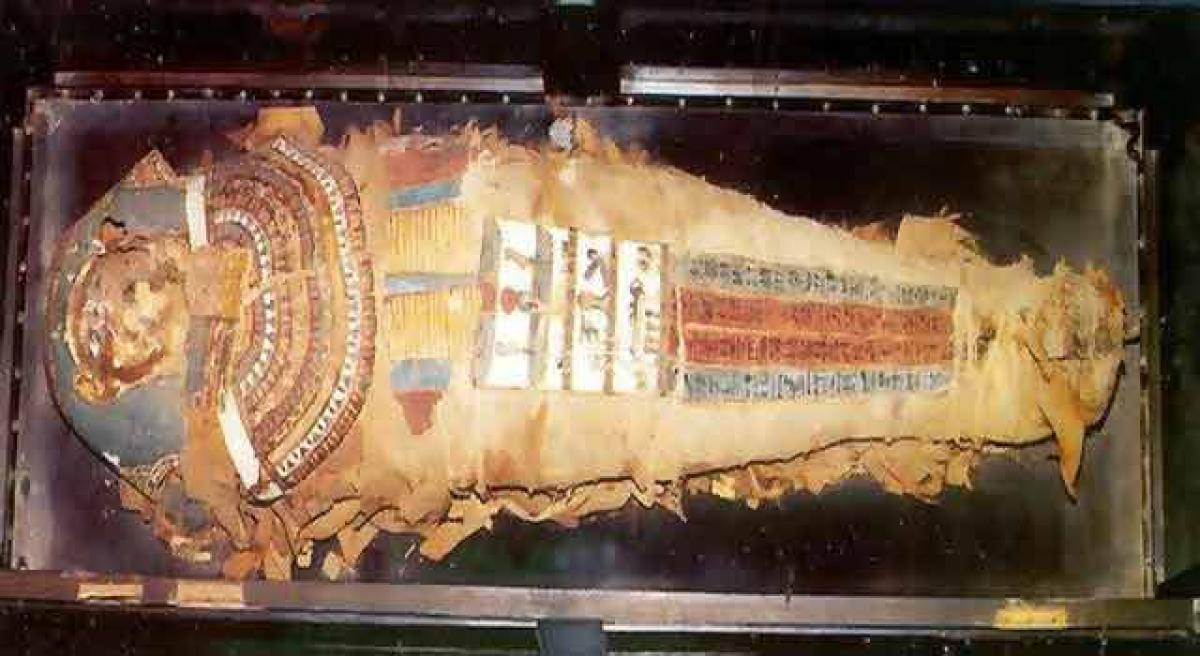Live
- Goa Aces clinch Indian Racing League title
- Study finds how hormone therapy can reshape the skeleton
- High-street fashion players looking at India for manufacturing: Report
- Shreyas Iyer to lead Mumbai as Prithvi Shaw returns for Syed Mushtaq Ali Trophy
- 'Failed to resolve crisis': NPP withdraws support from BJP govt in Manipur
- Chennai: Actress Kasturi Remanded in Custody Until 29th of This Month
- Aaqib Javed likely to become Pakistan's new white-ball head coach
- BJP panel to draft poll charge sheet against AAP govt in Delhi
- Allu Arjun Thanks Fans in Patna, Teases 'Pushpa 2' Release
- Japan to strengthen measures against illegal part-time jobs
Just In

Naishu, the mummy, daughter of the sixth Pharoah died during childbirth in 2,500 BC which was obtained by the sixth Nizam Mir Mehboob Ali Khan in 1920 was all along believed to be a 16-year-old but as part of the conservation efforts taken up by the Department of State Archaeology and Museums revealed that it was in fact a 25-year-old female.
Hyderabad: Naishu, the mummy, daughter of the sixth Pharoah died during childbirth in 2,500 BC which was obtained by the sixth Nizam Mir Mehboob Ali Khan in 1920 was all along believed to be a 16-year-old but as part of the conservation efforts taken up by the Department of State Archaeology and Museums revealed that it was in fact a 25-year-old female
- CT scan of mummy done for first time
- Linen falling apart put back in place
- Painted cartonage mended.
A CT scan and a bone test were conducted on the mummy, a first of its kind in India, revealed the exact age of the mummy. The mummy has a painted cartonage mask which covers the face. The painted surface was flaking and the cracks were consolidated using conservation materials such as Klucel-G.
The reasons for the deterioration of the mummy were humidity, heat, light and temperature. Now the mummy is placed in a case without oxygen and the temperature would be controlled.
Humidity and lack of a mechanism to control temperature in the case it was kept took a toll on the mummy and as a result the layers of linen wrapped around it were completely damaged at the head, toes and the base and the feet, head and the skull were partly exposed.
The Department of State Archaeology and Museums (DAM) started the conservation project few months ago and with the help of art conservation expert Anupam Sah of Chhatrapati Shivaji Maharaj Vastu Sangrahalaya, Mumbai, Vinod Daniel, heritage conservation advisor to the project who has worked on mummies in USA, Australia and Egypt undertook technical analysis including microphotography and CT scan.
N Visalatchy, director, DAM said, “The first phase of the conservation of the mummy is complete and a lot of interesting facts emerged in the process. A bone test revealed that it was a 25-year-old female of 136 cm height.
During mummification, most of her brain principal organs were removed. The ribs are damaged and there is a slight dislocation of her spine and one ankle. The rest of the bones, skull and teeth are intact.”
Vinod Daniel said that the usual practice was to remove all the organs, dry the body and wrap linen and place it in the tomb along with precious articles but in this case, the brain was left over inside the mummy.
There was also a metal inside the body. The mummy is now back in the museum and in the second phase extensive restoration of the cartonage would be taken up, says Visalatchy.

© 2024 Hyderabad Media House Limited/The Hans India. All rights reserved. Powered by hocalwire.com







